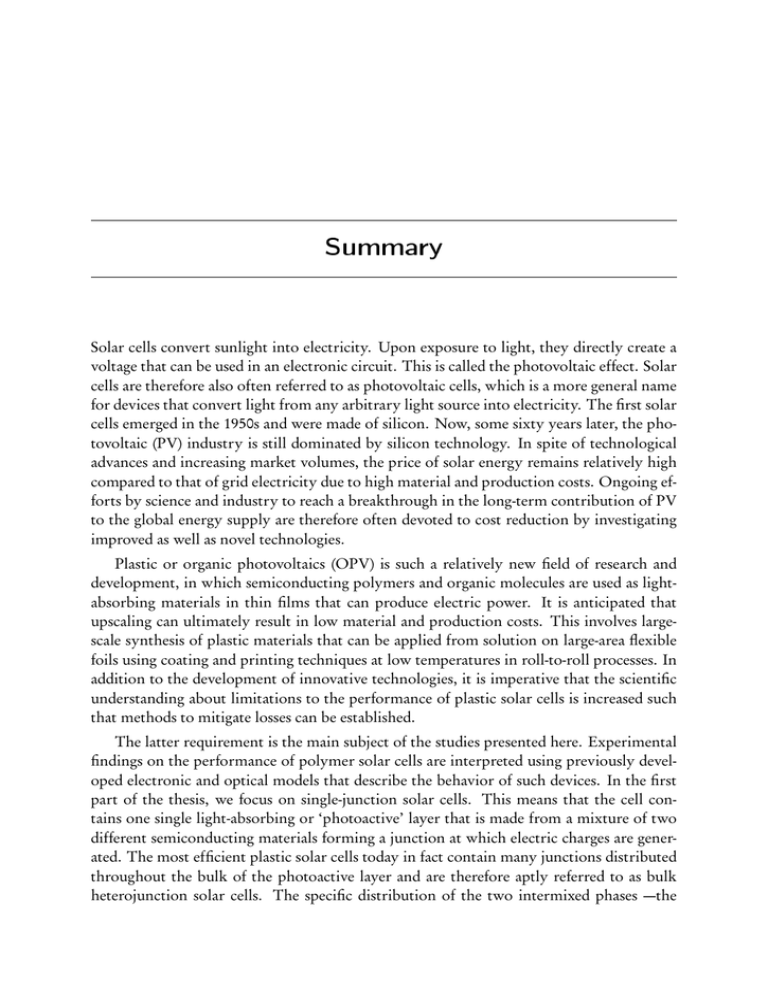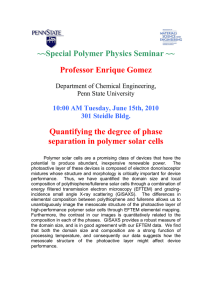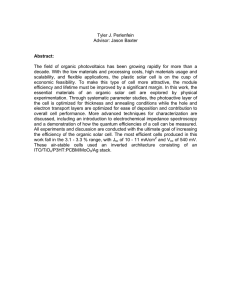Solar cells convert sunlight into electricity. Upon exposure to light
advertisement

Solar cells convert sunlight into electricity. Upon exposure to light, they directly create a voltage that can be used in an electronic circuit. This is called the photovoltaic effect. Solar cells are therefore also often referred to as photovoltaic cells, which is a more general name for devices that convert light from any arbitrary light source into electricity. The first solar cells emerged in the 1950s and were made of silicon. Now, some sixty years later, the photovoltaic (PV) industry is still dominated by silicon technology. In spite of technological advances and increasing market volumes, the price of solar energy remains relatively high compared to that of grid electricity due to high material and production costs. Ongoing efforts by science and industry to reach a breakthrough in the long-term contribution of PV to the global energy supply are therefore often devoted to cost reduction by investigating improved as well as novel technologies. Plastic or organic photovoltaics (OPV) is such a relatively new field of research and development, in which semiconducting polymers and organic molecules are used as lightabsorbing materials in thin films that can produce electric power. It is anticipated that upscaling can ultimately result in low material and production costs. This involves largescale synthesis of plastic materials that can be applied from solution on large-area flexible foils using coating and printing techniques at low temperatures in roll-to-roll processes. In addition to the development of innovative technologies, it is imperative that the scientific understanding about limitations to the performance of plastic solar cells is increased such that methods to mitigate losses can be established. The latter requirement is the main subject of the studies presented here. Experimental findings on the performance of polymer solar cells are interpreted using previously developed electronic and optical models that describe the behavior of such devices. In the first part of the thesis, we focus on single-junction solar cells. This means that the cell contains one single light-absorbing or ‘photoactive’ layer that is made from a mixture of two different semiconducting materials forming a junction at which electric charges are generated. The most efficient plastic solar cells today in fact contain many junctions distributed throughout the bulk of the photoactive layer and are therefore aptly referred to as bulk heterojunction solar cells. The specific distribution of the two intermixed phases —the morphology— has a strong influence on the efficiency and is sensitive to many factors, including the choice of solvent, processing technique and drying conditions. In Chapter 2, it is shown how the maximum attainable power conversion efficiency of solar cells based on a bulk heterojunction of a polyfluorene copolymer and PCBM (a soluble derivative of buckminsterfullerene) depends on the molecular weight of the polymer. A strong increase of the produced photocurrent with increasing molecular weight is observed experimentally, leading to a significantly enhanced device performance. We find that both light absorption and charge carrier mobilities do not change with molecular weight and thus cannot account for the observed effect. Rather, it is concluded from device-physical simulations that at high molecular weight the generation of free charges is more efficient, which is attributed to an improved separation of the polymer and PCBM phases. A similar effect is investigated in Chapter 3, which is concerned with the performance of plastic solar cells made of a small-bandgap semiconducting polymer and PCBM. The reduced bandgap of the polymer allows the absorption of light with lower energy —and thus a longer wavelength— that would not be harvested by common large-bandgap cells. We deliberately alter the drying conditions of the photoactive layer by introducing an additive to the solution. Again, the improved morphology of the bulk heterojunction leads to more efficient generation of free charges, which enhances the performance of the solar cells drastically. As an alternative for PCBM, one can use metal oxides such as zinc oxide (ZnO) together with a semiconducting polymer as photoactive layer. Different ways of producing the ZnO phase have been reported, one of which is investigated in Chapter 4. It involves dissolving the polymer together with an organozinc compound, which in the presence of moisture converts into ZnO during layer deposition and a subsequent thermal treatment step. A large variation in device performance is observed. Absorption measurements and an analysis of charge carrier transport indicate that an unwanted chemical side reaction takes place, which is avoided by replacing the polymer with a chemically more stable one. The optoelectronic properties of the polymer are now indeed unaffected by the conversion step and an enhanced power conversion efficiency is measured. The second part of this thesis aims at tandem polymer solar cells, which comprise two separate bulk heterojunction layers separated by a solution-processed middle electrode. Tandem cell architectures are particularly suited to combine two solar cells with different absorption spectra inside one device, in order to enhance the overlap with the solar spectrum. The realization of efficient tandem cells requires well-performing subcells as well as a transparent, conductive middle electrode. Furthermore, the middle electrode should have suitable electronic properties such that it simultaneously acts as an anode for one cell and as a cathode for the other. Chapter 5 investigates the properties of a solution-processed middle electrode that is made from ZnO nanoparticles and the conductive polymer PEDOT:PSS. Common PEDOT:PSS dispersions are strongly acidic, which makes deposition on top of thin ZnO films problematic due to dissolution of latter. We show that a modification of the acidity by addition of an organic base can be used to avoid this problem, but simultaneously changes the electronic properties of the PEDOT:PSS layer. As a result, it strongly limits the maximum performance of solar cells processed on top of it for polymers with specific electronic properties. A surface treatment that restores the anode quality is demonstrated, which enables double-junction solar cells producing a high open-circuit voltage. Strikingly, these double-junction solar cells —which comprise two equal bulk heterojunctions— show an ehanced performance over the optimized single-junction cells. In Chapter 6, we investigate the physical origin of this phenomenon. Experimental results, which are interpreted by optoelectronic modeling, indicate that optimized single-junction cells are rather thin due to significant electronic losses in thicker layers. Light absorption, however, is not optimal in thin cells. The tandem structure therefore serves to disentangle electronic and optical limitations that inevitably occur simultaneously in single-junction cells. In the last section of this thesis, Chapter 7, we turn to tandem cells based on two different bulk heterojunction systems. Optoelectronic modeling is applied as a predictive design tool. First, an analysis is made of various criteria that can be used to optimize tandem polymer solar cells and the results are compared to experimental results from literature. A large difference in the optimal subcell layer thicknesses is found when the optimization is performed on the basis of optics and electronics simultaneously compared to optics alone. Next, the additive processing described in Chapter 3 is considered for a subcell of a tandem device and the influence on its optimal performance is assessed by simulations. The results show that the beneficial effect of the additive on the maximum attainable efficiency is smaller in the tandem device than in the single-junction cell. As a final case study, we estimate the optimal efficiency and device structure for a tandem cell based on two highperformance polymers. The calculations show that a relative increase of 25% in efficiency can be expected if the cell has a conventional bottom-anode-top-cathode structure. An inverted tandem device, in which the order of the electrodes is reversed, is demonstrated experimentally and optimized by simulations. The calculated optimal performance is lower compared to that of the regular structure due to less appropriate light incoupling, causing stronger electronic losses.

